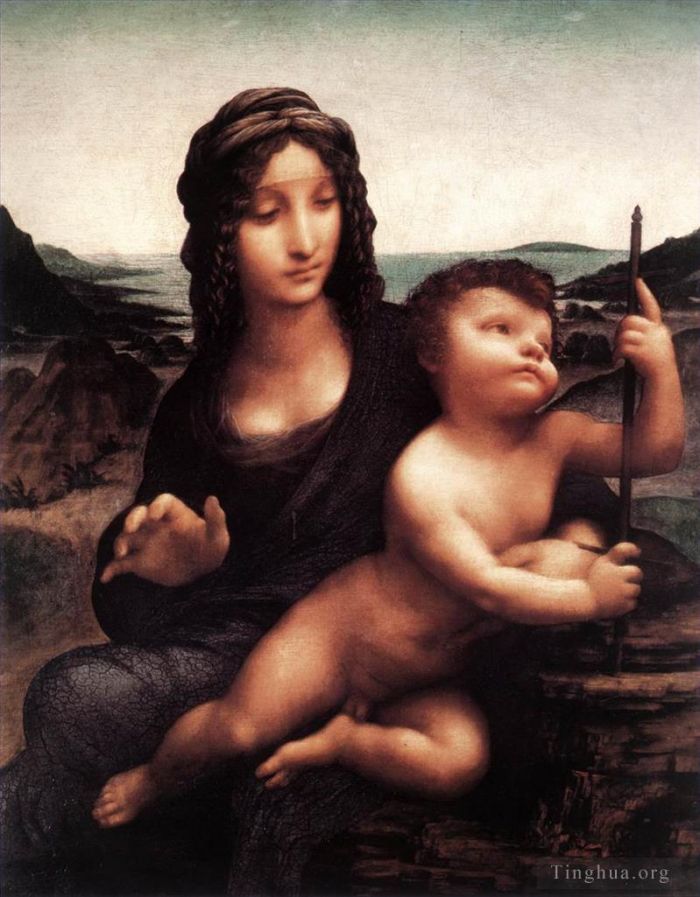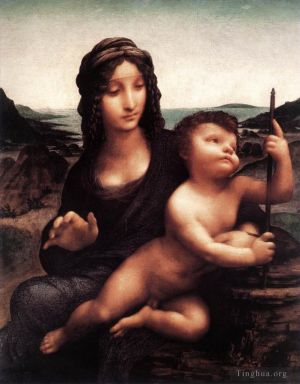Madonna with the Yarnwinder 1501
Leonardo da Vinci
- Price:
- Art Type: Oil Painting
- Size:
- English Comments: 0
- International Comments: 0
- Creating Date:
- Introduction and Works of Leonardo da Vinci >>
Keywords:
Madonna, Yarnwinder
Work Overview
- Artist Attributed to Leonardo da Vinci and another artist
Type Oil on walnut
Dimensions 48.3 cm × 36.9 cm (19.0 in × 14.5 in)
Location Scottish National Gallery, Edinburgh (on long-term loan from the Duke of Buccleuch’s collection)
Owner Richard Scott, 10th Duke of Buccleuch
The Madonna of the Yarnwinder (Italian: Madonna dei Fusi, “Madonna of the Spindles”[1]) is a subject depicted by Leonardo da Vinci in at least one, and perhaps two paintings begun in 1499 or later. Leonardo was recorded as being at work on one such picture in Florence in 1501 for Florimond Robertet, a secretary to King Louis XII of France. This may have been delivered to the French court in 1507, though scholars are divided on this point. The subject is known today from several versions of which two, called the Buccleuch Madonna and the Lansdowne Madonna, are thought to be partly by Leonardo’s hand. The underdrawings of both paintings show similar experimental changes made to the composition (or pentimenti), suggesting that both evolved concurrently in Leonardo’s workshop.
The composition shows the Virgin Mary seated in a landscape with the Christ child, who gazes at a yarnwinder used to collect spun yarn. The yarnwinder serves both as a symbol of Mary's domesticity and as a foreshadowing of the Cross on which Christ was crucified. The painting's dynamic composition and implied narrative was highly influential on later High Renaissance depictions of the Madonna and Child by artists such as Raphael and Andrea del Sarto.
The earliest reference to a painting of this subject by Leonardo is in a letter of 14 April 1501 by Fra Pietro da Novellara, the head of the Carmelites in Florence, to Isabella d'Este, Marchioness of Mantua. Leonardo had recently returned to his native city following the French invasion of Milan in 1499; the intervening years he had spent first in Isabella’s court, during which brief stay he produced a cartoon (now in the Louvre) for a portrait of her, and then in Venice. Isabella was determined to get a finished painting by Leonardo for her collection, and to that end she instructed Fra Pietro, her contact in Florence, to press Leonardo into agreeing to a commission. Two letters of reply by the friar survive. In the second, written after he had succeeded in meeting with the artist, he writes that Leonardo has become distracted by his mathematical pursuits and is busy working on a small painting for Florimond Robertet, which he goes on to describe:
"The little picture which he is doing is of a Madonna seated as if she were about to spin yarn. The Child has placed his foot on the basket of yarns and has grasped the yarn-winder and gazes attentively at four spokes that are in the form of a cross. As if desirous of the cross he smiles and holds it firm, and is unwilling to yield it to his Mother who seems to want to takeit away from him."[2]
The passage is valuable for being one of the few descriptions by a contemporary viewer of a work by Leonardo; it matches the composition of the Buccleuch and Lansdowne Madonnas in all respects except that there is no basket in either painting.[3] Robertet’s painting was probably commissioned late in 1499 just before Leonardo left Milan, and was possibly begun there.
Scholars disagree on whether Robertet received his painting or not. In January 1507 Francesco Pandolfini, the Florentine ambassador to the French court in Blois, reported that “a little picture by [Leonardo’s] hand has recently been brought here and is held to be an excellent thing”.[4] The Madonna does not, however, appear in a posthumous inventory of Robertet’s collection made in 1532 (though the authenticity of the inventory has been called into question).[3] One hypothesis holds that it passed from Robertet’s collection into that of the French king, thus explaining its absence from the inventory. It is unclear, however, why it would have left the royal collection.[5]
In 1525 two inventories were drawn up of the possessions of Leonardo’s assistant and heir Salaì, who died the preceding year. These mention a “Madonna with a Child in her Arms”. This is thought to be evidence that one of the prime versions of the Madonna of the Yarnwinder remained in Leonardo’s possession while the other was sent to Robertet.[6]
Neither of the paintings accepted as prime versions has a provenance that can be traced back to Robertet or Salaì, or further back than the 18th century, though the Buccleuch Madonna was in France at that time. However, the Lansdowne Madonna could easily have been bought by its earliest known owners from a French collection in the period following the French Revolution, when many works with a French aristocratic provenance were bought by British collectors.
--------------------------------------------------
Ever since his 20s, when he drew a toddler playing with a cat in a series of impressionistic sketches, Leonardo da Vinci had tried to capture the fun of children at play. In his design for The Madonna of the Yarnwinder, he achieved it. This painting is a monument to childish energy. He does not expect us to search for theological significance in its touching observation of a cheekily playful child steadied by a loving, tender mother.
But it is a masterpiece with a catch. How much of this painting did the master actually do?
Leonardo definitely designed it – an eyewitness account describes him doing so. But the Duke's painting is one of several versions of the picture, none of which can be entirely by Leonardo.
There are lots of weaknesses as well as strengths: its landscape has none of the intensity of those painted by his own hand, nor could you seriously set this Madonna's face alongside that of the Mona Lisa for quality. No one disputes it was made in his workshop by his pupils, but how much did he help?
Since it was exhibited at the National Gallery of Scotland in 1992, arguments for a heavy involvement by him have got a hearing. Recent scientific studies appear to prove that Leonardo sketched out the design on the canvas – changes of mind are visible under the paint.
It's undoubtedly a lovely thing; and even a picture he got his pupils to knock up under his supervision is something to treasure. The merest touch of Leonardo's genius is better than almost anyone else's signature work.
------------------------------------------------
Leonardo did complete this very small painting but the original has probably been lost. Several copies still exist and there is strong speculation that two of these are from the hand of Leonardo himself, but this is still the subject of some debate and they could just have easily come from talented pupils. The original work can be securely dated at 1501 as a letter from April of that year mentions Leonardo is working on Madonna of the Yarnwinder.
One of the most interesting and complete sketches Leonardo ever did was for this painting; a close look shows this work was based around the geometric figures of triangles and ellipses. An excellent red chalk drawing of the Madonna's head and shoulders also exists in the Royal Collection at Windsor Castle.
This work, intended for Florimond Robertet, Secretary to the King of France, shows the winder as shaped like a cross; this symbolises the Passion of Christ and His future death. It appears that Mary wants to pull the Child away from the symbol of His future, but even she is powerless to prevent the Crucifixion which is part of His destiny. Of the two works one is very green whilst the other is quite blue; the landscapes also differ significantly with one showing a vicious mountain range beneath a vivid blue sky while the other runs down to the sea.
Leonardo prepared for paintings that included the Christ child or the infant St. John the Baptist by drawing dozens of studies of little children. Most of his children appear between nine and eighteen months, all are shown nude and all look similar enough as to make the viewer wonder whether the one child modelled for each painting.
This painting is sometimes called Madonna of the Spindle or the Madonna with the Distaff.
- Copyright Statement:
All the reproduction of any forms about this work unauthorized by Singing Palette including images, texts and so on will be deemed to be violating the Copyright Laws.
To cite this webpage, please link back here.
- >> English Comments
- >> Chinese Comments
- >> French Comments
- >> German Comments
- >>Report
- Leda 1508
- Portrait of a musician
- The Virgin of the Rocks 1491
- Madonna and Child with Flowers (Benois Madonna)
- The Annunciation
- Madonna and Child with a Pomegranate
- Portrait of Ginevra Benci
- La belle Ferroniere
- Baptism of Christ
- St John the Baptist
- St John in the Wilderness (Bacchus)
- Madonna Litta
- Leda 1530
- The Virgin and Child with St Anne
- Madonna with the Yarnwinder 1501
- Madonna with the Yarnwinder after 1510
- Saint Jerome
- Leda 1510
- Portrait of Cecilia Gallerani (Lady with an Ermine)
- Leda and the Swan 1505
- The Madonna of the Carnation
- Mona Lisa
- Vitruvian Man
- Design for St Anne
- Study of a womans head
- Allegory with wolf and eagle
- Battle of Anghiari Tavola Doria
- Study of a rider
- Study for the Last Supper Judas
- Rearing horse
- Study sheet with horses and dragons
- Madonna and Child with St Anne and the Young St John detail1
- Studies of human skull
- Study for Madonna and Child with St Anne Drapery over the legs
- Study of hands
- Anatomical studies of the shoulder
- Star of Bethlehem and other plants
- Battle of Anghiari
- Drawing of the Torso and the Arms
- Adoration of the Magi
- Study of St Anne Mary and the Christ Child
- Ceiling decoration
- Study of horses
- Studies of Leda and a horse
- Womans Head
- Study for the Last Supper
- The Last Supper
- Landscape drawing for Santa Maria della Neve on 5th August 1473









 Singing Palette
Singing Palette